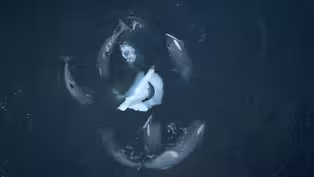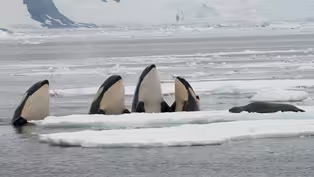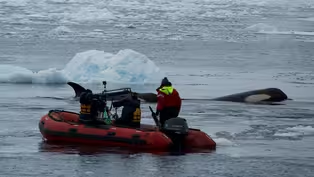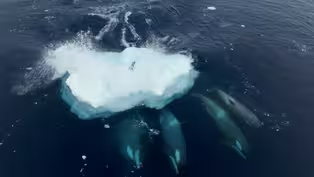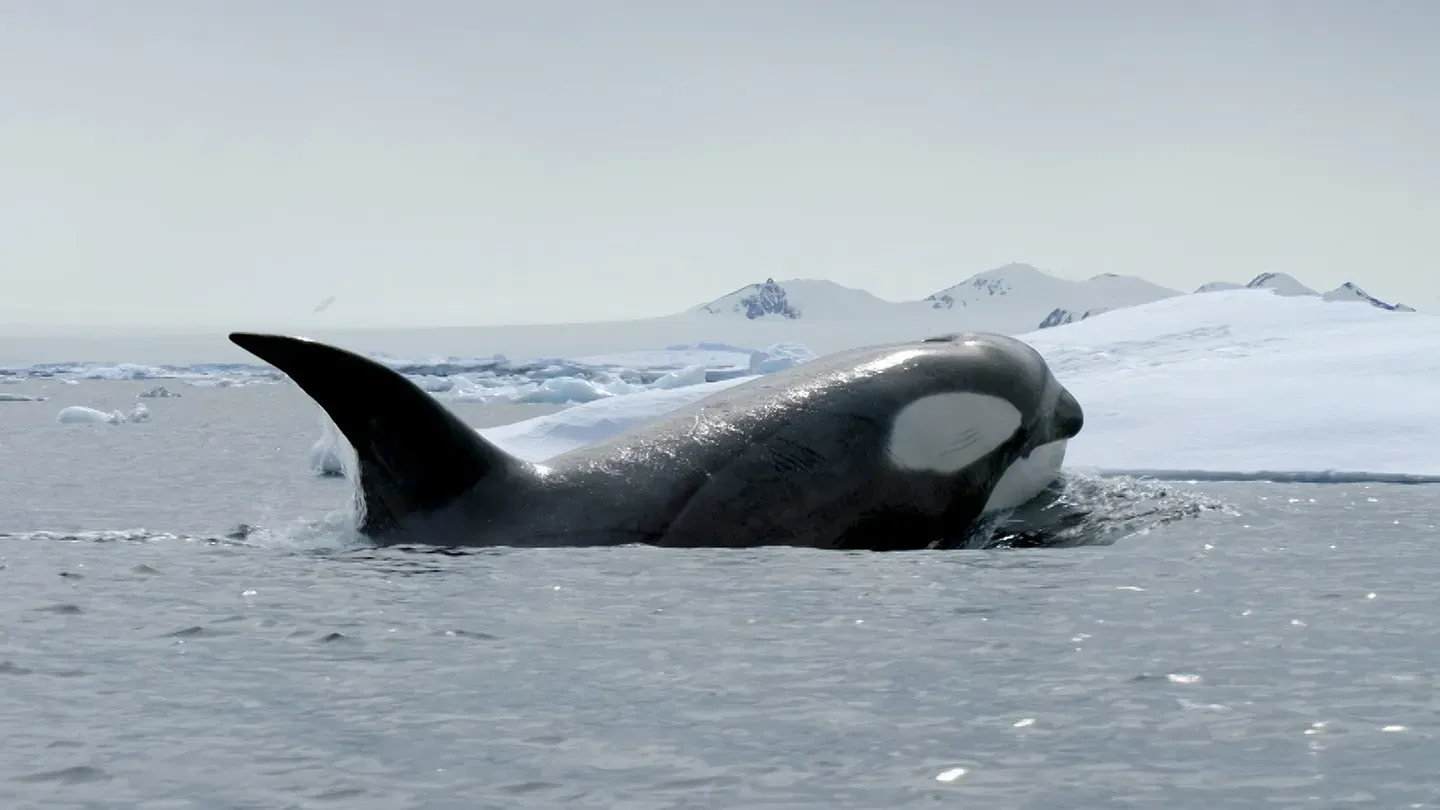

Expedition Killer Whale
Season 43 Episode 8 | 52m 51sVideo has Audio Description, Closed Captions
A team of scientists and filmmakers explore the Antarctic waters to learn more about killer whales.
Follow a team of scientists and filmmakers in Antarctica studying the most sophisticated hunting strategy in the animal kingdom - killer whales making waves to wash seals off floating ice.
See all videos with Audio DescriptionADProblems playing video? | Closed Captioning Feedback
Problems playing video? | Closed Captioning Feedback
Major support for NATURE is provided by The Arnhold Family in memory of Henry and Clarisse Arnhold, The Fairweather Foundation, Sue and Edgar Wachenheim III, Charles Rosenblum, Kathy Chiao and...

Expedition Killer Whale
Season 43 Episode 8 | 52m 51sVideo has Audio Description, Closed Captions
Follow a team of scientists and filmmakers in Antarctica studying the most sophisticated hunting strategy in the animal kingdom - killer whales making waves to wash seals off floating ice.
See all videos with Audio DescriptionADProblems playing video? | Closed Captioning Feedback
How to Watch Nature
Nature is available to stream on pbs.org and the free PBS App, available on iPhone, Apple TV, Android TV, Android smartphones, Amazon Fire TV, Amazon Fire Tablet, Roku, Samsung Smart TV, and Vizio.
Buy Now
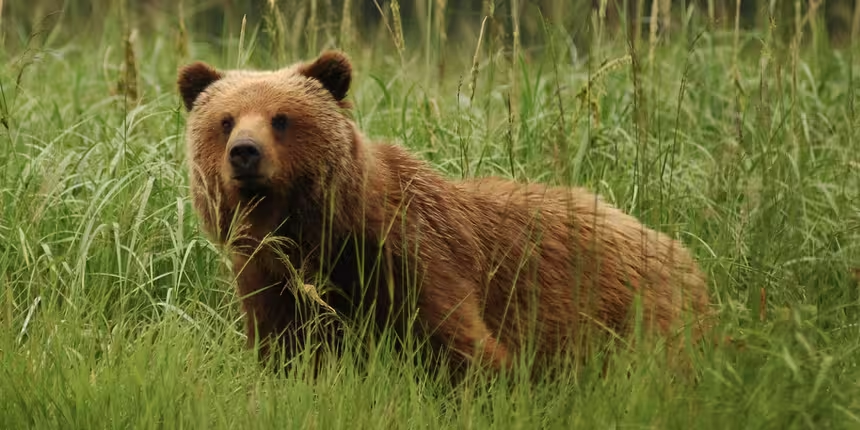
Explore More Ways to Watch
Bring the beauty and wonders of wildlife and natural history into your home with classic NATURE episodes.Providing Support for PBS.org
Learn Moreabout PBS online sponsorship♪♪ -Killer whales are one of the most successful predators on the planet.
But one tiny group living in Antarctica hunts like no others.
Swimming in tight formation, they create waves so powerful and accurate, they can wash a seal right off a piece of floating ice.
♪♪ This behavior has intrigued scientists for decades... and it's earned the whales a fearsome reputation.
But they are not simply ruthless killers.
They have close families with complex lives we know little about.
So, a hand-picked team of scientists and filmmakers are heading to the Antarctic Peninsula to unlock the secrets in the lives of these whales.
-We're about to catch our first glimpse of Antarctica and possibly of killer whales.
-We really want to witness the power of the waves, the sound of them crashing.
It is utterly spectacular.
-Antarctica's changing rapidly, and so it's paramount that we learn as much as we can about them before we reach some sort of tipping point.
-But with only a few short weeks of good weather, the pressure is on.
♪♪ ♪♪ -The team is heading deep into the Antarctic, to an area where whale biologist Leigh Hickmott has studied these killer whales before.
-In this part of Antarctica, the population is only around a hundred animals, and that's been declining at approximately 5% per year.
So, coming down here, learning more about them, and then ultimately how they conduct their lives in this environment, that's what we want to understand.
-But with a search area of 50,000 square miles, the team will have to stay on constant watch.
-The critical element is spending time at the top of the boat, as high as we can be, binoculars glued to our eyes.
-This is such a shifting landscape, and everything is moving all the time, the killer whales, the boat, the ice.
It's like looking for a needle in a wet and very moving haystack.
-We have these small windows of opportunity to try and unlock all these secrets, so any little bit of data we get is so, so valuable.
I better stop talking and start searching.
-Trying to find a black-and-white killer whale in a black-and-white landscape is tricky.
-These killer whales are easily capable of covering over a hundred miles a day.
We're doing between 50 and 100 miles a day, but whether we're doing it in the right direction, that we'll have to wait and see.
♪♪ -Okay, there's a group up.
♪♪ -So, can you see the triangular-shaped island bit in the middle of that straight down from it, that's where they just blew some air.
First time ever seeing killer whales, so I think we're off to a pretty magical start.
-Everything we could have hoped for on day one, with such a short window to work in, and hopefully they're animals that I know, so it's kind of like finding old friends again.
-The team heads out to meet them.
-We need to go out in the zodiac.
Jess, are you happy to shoot photo ID?
-Yep.
-Okay, so, let's head this way, Dave.
So, we give them some space.
♪♪ -They are absolutely enormous.
You can't really appreciate the scale of them until they're next to a six-meter zodiac.
-Pack ice killer whales can grow to over 25 feet in length.
-See him?
-Oh, wow.
It's Kinzel.
-This is a whale Leigh knows well.
-This killer whale is named Kinzel because he's got a very distinct sort of K shape to the trailing edge of his dorsal fin.
-Kinzel is a young teenager, and he's with his little sister, six-year-old Georgie.
But the most critical member of the family is missing -- their mother, Gerty.
-I've never seen Kinzel without Gerty.
They're mother and son, so they're always together or should always be together.
-After seven trips to the Antarctic, Leigh feels a deep connection to Gerty.
-Our core reason for being here is to find any pack ice killer whales.
But of course, you end up with favorites, and one of my favorites, I call her Gerty.
She's named after my gran because my gran had ten children, so she was definitely a matriarch, an incredibly strong female and that's exactly who Gerty is as well.
-Gerty is the most accomplished pack ice killer whale Leigh has ever studied.
-She's taught me everything I know about pack ice killer whales.
Gerty has really honed her hunting technique, so she's one of the most successful at feeding her family.
For me, Gerty is just the boss.
-And Leigh can easily recognize her.
-Clearly, she's had a challenging life.
You can see that in her dorsal fin shape.
And that's got two really large notches on the leading edge, and then she's got a small nick, a piece taken out of the trailing edge of her dorsal fin as well.
-An experienced matriarch, her parenting is critical to both Kinzel and Georgie.
Like killer whale families all across the world, sons, daughters, and grandchildren stay with their mothers their entire lives, relying on her knowledge of where to find and how to catch food.
As females age, they go through menopause.
They stop having offspring in their 40s but can live to over a hundred years old.
Survival beyond childbearing years is rare in mammals, but it allows these matriarchs to devote the rest of their long lives to passing on their knowledge and experience.
Without them, their families could die out.
For Leigh, studying the matriarch is the best way of understanding killer whale behavior, and he learns more from Gerty than any other.
-So, are you a bit worried that you can't see Gerty, then?
-I am, because if we have a matriarch die, then you can almost see the pod collapse completely.
-Finding Gerty is now Leigh's top priority.
Also on this expedition is marine biologist Jess Farrer.
She's here to investigate the health of the killer whales and the world they live in.
-We're just trying to get a 360-degree view, so that we can understand what they need to thrive.
-But to do this, she'll have to get her hands dirty.
-What I'm doing is looking for poo.
There's all sorts of information you can get from poop.
It's really like having the food chain just laid out in front of you.
People think you're going to go, you're gonna do marine biology, and you're going to walk around on a beach with a camera in a bikini.
No.
You're going to be massaging turds with your hands.
-But finding a poo, or scat, floating in the Southern Ocean is easier said than done.
If Jess succeeds, she'll be the first person ever to collect a scat sample from a pack ice killer whale.
But even with 24 hours of daylight, there have been no more sightings since the team found Kinzel and Georgie.
-It is, believe it or not, actually nighttime.
I can't remember how late it is, something like 10:00 or 11:00 p.m., but it's still very light.
Antarctic summer.
♪♪ -They keep looking, but over the next few days, they face a new challenge... ...a lack of pack ice.
♪♪ Pack ice is the name given to free-floating pieces of ice that form as the frozen Southern Ocean breaks up after winter.
These mobile platforms provide the perfect place for seals to haul out... ...and a resting seal is the ideal target for hungry wave-washing pack ice killer whales.
♪♪ But in 2023, Antarctica's sea ice reached its lowest level since records began.
-We're now traveling through open water, not through pack ice.
It's broken up and disintegrated to nothing.
That's a huge concern for the killer whales, and particularly, for example, for Gerty's family.
I've seen her here every year.
This really is her patch, her core foraging zone at this time of year.
And now what should be pack ice is open water.
Now is the time when they should be feasting on seals that would be out on the pack ice.
If they're not here finding good amounts of food, then they're having to travel further between meals.
If Gerty starts to lose body condition, Kinzel, that huge son of hers that we saw, their health is going to suffer as well.
♪♪ ♪♪ -So, the team has to travel farther, too.
♪♪ ♪♪ After days of searching, the boat hits ice.
♪♪ -So nice to see this much pack ice.
Finally on the search.
-Oh, they're out here somewhere.
It's constant effort to find them in this environment.
Even when you have two zodiacs in the water and a drone in the air, all it takes is, you know, them feeding behind an iceberg, and you drive by and you never know.
-Killer Whale country.
-Oh, my gosh, there they are.
-Pack ice killers.
-Do you know which group this is?
-It might be Marge and Tickle.
-Leigh can recognize many of the whales by the shape of their dorsal fins and the marks on their backs.
-Oh, there's a seal.
There's a seal here.
Right here.
-It's a leopard seal.
-Dave, Dave, from Leigh.
-Go ahead, Dave.
-Killer whales are up at our 11:00.
-Yeah, I copy.
-Okay, they're spy hopping all around the leopard seal now.
-Killer whales beat their tails to lift themselves up to 10 feet out of the water, a behavior known as spy hopping.
-These leopard seals can be aggressive, and they are certainly intimidating.
They eat crab eaters, elephant seals, fur seal pups like candy, like chicken nuggets.
-Far more aggressive than a Weddell seal the leopard seal sits just below killer whales as Antarctica's top predator... ...growing to 12 feet long and weighing over 1,000 pounds.
Agile enough to twist like a snake and with a wide gape of razor sharp teeth, they are dangerous.
A killer whale will rarely risk hunting a leopard seal.
As Marge continues to spy hop, the leopard seal begins to climb.
-So, the leopard seal is now managed to get to high ground.
It doesn't look comfortable.
I mean, I wouldn't be, but it doesn't look comfortable.
-But with only her young calf to help, Marge won't risk taking on the leopard seal.
-Okay, there is, yes, there's now four whales approaching.
-Out of nowhere, reinforcements arrive... -Now you're well and truly surrounded by pack ice killer whales, everyone.
-...and get straight to wave-washing.
The killer whales' first wave is designed to reduce the size of the ice... -He's broken the piece almost in half.
-...which will increase the impact of the waves to follow.
But the leopard seal has a countermove.
-The leopard seal's now hiding in this channel that's been left in the ice.
-The killer whales stop to assess the situation.
-They seem to be having a discussion.
-I mean, from what I can see, I think there might be some more waves coming.
-In an incredible display of coordination, they approach from a different angle.
Swimming on their sides, the whales drive as much water upwards as possible.
The faster and closer to the surface they swim, the taller the wave.
-So, they're increasing the amplitude and the power in each of the waves to really flush the leopard seal out.
-This is gonna be amazing.
-With a synchronized flick of their tails, they aim the full force of their wave directly at the seal.
But the seal has the strength to hold on.
An hour and a half in, the whales continue to spy hop to plan their next move.
-I can almost sense their frustration.
♪♪ ♪♪ -I'd say only a handful of people on this planet have actually seen wave-washing firsthand.
I mean, I've been coming to Antarctica since 2009.
That's the first time I've seen that behavior.
-The leopard seals are really agile, so it's able to jump straight back out onto the ice, something that a Weddell seal wouldn't be able to do.
That means for the killer whales, they have to make lots more waves, because what they need is the seal in the water in order to catch it.
-This is a battle between Antarctica's top two predators.
♪♪ ♪♪ For two hours, the whales send wave after wave at the seal.
-He's still up there but fighting to stay on.
You think about the amount of energy that is expended to catch one seal.
♪♪ ♪♪ -Eventually, the exhausted leopard seal can fight no more.
♪♪ ♪♪ The killer whales deliver one precision bite to its powerful swim muscles.
-Man, they've earned this seal.
-What a team effort.
It isn't a me, me, me culture.
They're sharing this leopard seal between all the group members so that everyone benefits.
-The hunt may be successful, but it's been costly.
18 waves for just one leopard seal.
Most Weddell seal hunts take just four.
And with each whale needing to eat an average of a seal a day, they can't afford to expend this much energy on every hunt.
-Now they've completely vanished.
You wouldn't know there was any killer whales here if you looked, turned up now.
You wouldn't know that one of the world's most intelligent animal behaviors has just occurred right there.
♪♪ ♪♪ -Leigh and Jess want to review Sam's drone footage to see if the aerial view reveals anything new about the killer whales' hunting behavior.
-That's cool to see how much they pump their tail to get up and out to spy hop.
-I think it's crazy how they, like, the other whales, just came on the scene, and it's not like they checked it out first.
They just immediately started swimming towards it, so that makes you think that that female actually communicated, "There's a seal and it's on this iceberg, swim that way."
-So, yeah, because the mum and the calf were there for a long time together, just the two of them.
She had to have made a call because those other animals have come in from afar and immediately made the wave with her.
-The camera team has captured something never filmed before.
Not only must Marge have called for help, but she also seemed to instruct the new arrivals on precisely where to go and what to do.
-Tom, Sam, and Helen are giving new insight into the behavior.
-Now, Leigh wants to investigate how pack ice killer whales communicate during their hunts.
♪♪ But the Antarctic weather can make searching for whales difficult.
♪♪ -We can't see any killer whales from our vantage point at the moment.
-Yeah, I've got a drone view of the whole bay, and I can't see a single killer whale.
♪♪ ♪♪ -Just beyond that iceberg there.
♪♪ -Okay, they're up ahead of us.
-They've come out and they're moving along the ice edge.
It'd be good to try and get out and make a recording of them.
-Leigh and Jess head out.
This time, Leigh is bringing a hydrophone, a microphone capable of picking up underwater sounds so he can listen to their communication.
-Killer whales around the world use sounds in a lot of their behavior, and pack ice killer whales may be very similar.
We just don't know.
So, anything that we can collect here is incredibly valuable.
-If successful, he will be the first to record their acoustics.
-I think there's about five around here.
One just spy hopped at 11:00.
Oh, that might be Gerty.
Try and get photos -- animal on the left.
♪♪ I know her.
That's Jenny and her offspring, Clicker.
-Every encounter with a matriarch provides valuable data.
-The more data we collect, the more we understand.
The more we understand, the more we can take those conservation steps in the future.
-Right here, look, that is a big whale.
-So, every time we are able to find a group and see who's there, we're getting a lot of information that is feeding into our understanding of this population as a whole, and that's really critical.
♪♪ Look at the calf coming to say hello.
-Jenny and Clicker aren't alone.
They are in a large group with a lot of calves.
-I can see one, two, three.
At the moment, we've got this group that they're not out as mindless killers, they're there socializing.
-Socializing is an essential element in the lives of pack ice killer whales.
-These animals are not just hunters.
They're complex social animals with tight family units and even tighter family bonds.
-Leigh listens to the whales as they interact with each other.
-Can you hear them?
I can hear them.
So many pulse calls and whistles.
It's so ethereal.
It's so otherworldly.
The pulse calls are predominantly used when the animals are socializing, and whistles typically can be used where the family group are establishing and renewing their bonds between one another, particularly, for example, between a mom and her offspring.
This is the first time pack ice killer whales have ever been recorded.
-Leigh continues to listen to the group for several hours as they look for a suitable meal.
♪♪ ♪♪ ♪♪ -Typically, killer whales are quiet when they're searching for prey because sound travels incredibly well in water, and so they could alert their prey to their presence.
What's interesting here, because their prey is out on the ice, it seems these pack ice killer whales are okay with vocalizing, and that's never been known before.
It's completely new.
Literally what we're hearing this second is new.
We're watching searching for prey happening, and the animals are being very vocal.
Those seals have no idea.
It's amazing.
-Somehow, the killer whales understand that seals on the ice cannot hear them vocalizing underwater... ...so they can communicate freely, knowing it won't scare their prey away.
♪♪ ♪♪ Finally, the whales find a crabeater seal.
They may be the most abundant seal in Antarctica, but they're small and feisty, so they sit low on the killer whales' menu.
♪♪ ♪♪ Jenny tentatively tips the seal into the water.
-Oh, he just went in.
He's back out, he's out.
He's in the middle.
♪♪ ♪♪ -This does not look like normal hunting behavior.
♪♪ Now Jenny uses her teeth to gently pull the seal into the water.
-The same way that we can hold something very, very carefully with our fingers, they're able to do that with their teeth and jaws.
♪♪ -She moves back and lets the calves have a go.
♪♪ -You know, it's a visual learning experience, so I'll show you, and then I'll hang back, and then you repeat.
-Teaching behavior like this has never been filmed before.
-This could be over so quickly, and yet it's drawn out because of the learning that's happening.
-I think one of them has it in its mouth.
-Using her snout, Jenny swims the seal away from the safety of the ice... -See how the calf comes next to mom when she's pushing the seal here.
-...then releases it again... ...letting the calves practice the maneuver.
-They repeatedly let prey go in order for the young to learn, and that's a real gamble for them, because that prey could get away, and then that's a meal lost.
-Killer whales are one of only a handful of animals that actively teach their young, and it's the females that take on this duty, ensuring the survival of their families.
-Mothers and grandmothers and aunts take a lot of time teaching their offspring exactly how to do these complex behaviors.
Similar to us as humans, they have culture in their society, and that they're passing on information to one another that is benefiting not only themselves, but other group members.
-Killer whale culture relies on this transfer of knowledge from generation to generation.
It's how pack ice killer whales have developed the most sophisticated hunting strategy on the planet.
But to learn from the queen of wave-washing, the team must find Gerty.
Over the next few days, they put everything into looking for her.
♪♪ ♪♪ They spot a group of killer whales, but it's what they've left behind that interests Jess.
-It's just this sort of diffuse sort of cloud that comes out from behind the killer whale, and you have to look really close, otherwise you'd miss it.
But Sam said he's seen it, so let's go get it.
-If they reach it in time, Jess will finally be able to analyze the health of the whales.
But they must hurry.
Scat breaks up quickly in water.
-Are we sure we haven't run over it?
-Yeah, I mean, the piece we saw was literally like my fingernail size, if that.
-That's all I need.
There's no way we're finding that again.
-Oh, here.
Here.
Here, here.
There, there.
There.
-Right there.
Let me just go forward, forward, forward, forward.
-Got it?
She got it.
-Got it.
-She got it.
-World first.
This has never been collected before.
It's the tiniest little bit of scat.
But my favorite part is its non-invasive research.
So, I'm pretty... what do you say?
Chuffed?
-We do say chuffed.
-I'm right chuffed.
-[ Laughs ] -Whoever thought somebody'd be this excited over a poo?
-[ Laughs ] -Whoo!
-But for Jess to be absolutely sure, she needs to find killer whale DNA in it.
This has never been done on a boat in Antarctica.
-In theory, that tiny little bit of what looks like water should have the DNA in it.
Should have.
Doesn't mean it does, but it's supposed to.
Okay, um... moment of truth when I hit the green button.
I'm really nervous.
Aah, it's sequencing.
So, there's DNA in it.
It worked.
It's just insane that that can be processed inside of the cabin on this tiny little ship that's rocking around in the Southern Ocean.
-The presence of DNA is huge.
It means Jess will be able to test for contaminants or parasites and analyze the stress levels of the killer whales.
She's got her science gold.
But Leigh has yet to find his.
♪♪ -We're only looking quite literally for a handful of animals, so the magnitude of the task has become very real for everyone.
When you feel like there's time pressure, it's as if time goes even more quickly.
I definitely feel that, and I'm aware of that as each day passes.
We're all chomping at the bit to really get that one more chance.
♪♪ -You guys have eyes on her?
-I think I've got them.
♪♪ I got them.
♪♪ -Okay, I see them.
Oh, it's Kinzel.
And it's Gerty.
This -- This is incredible.
Really brilliant.
-Leigh can once again study the whale that's taught him the most and embodies everything that makes pack ice killer whales so extraordinary.
-It's rare for me to feel I have a bond with an animal.
Seeing her with her son and Georgie, I do feel I have that link to her.
♪♪ ♪♪ -Like her namesake, Gerty is also a grandmother, and all three generations are here.
♪♪ ♪♪ -They have so much personality.
It's really incredible to watch them just be a family together.
♪♪ -Okay, I'm going out with acoustics.
-Thought of recording Gerty is -- is -- it's really cool.
♪♪ ♪♪ ♪♪ And there's a lot of vocal behavior happening.
Lots of whistles between Gerty and Georgie as they establish and keep that family connection.
♪♪ -They're swimming up to that crabby that's on that flat piece of pack, aren't they?
-Guys, they're gonna line up on this -- this crabby that is ahead of you, Dave, by about 3 or 400 meters.
Sam, Sam, get ready for a hunt.
Here they come.
Here they come.
-Gerty leads her family to a crabeater seal.
-Spy hopping the seal.
-She's spy hopped this berg about seven times from all angles, but now there's about four or five other animals coming just behind this berg.
♪♪ Did they leave it?
Yep, they've moved on.
-Like all pack ice killer whales, Gerty can differentiate seal species.
But what really sets her apart is her exclusive focus on Weddells, the seals that offer her the highest chance of success.
So, she leads her family on.
-Red zodiac needs to turn left 90 degrees, Dave.
-Being in the zodiac in that moment as killer whales come right underneath the boat, I'm very aware that they are incredibly intelligent and powerful animals, and if they wanted to, they could flip us over in a heartbeat.
You just sort of sit and you wait and maybe once they finished popping up and having a look and they move away, you kind of release a breath.
-They have just dived, so they're not at the surface anymore.
-Suddenly, the whales dive, disappearing from view.
Leigh listens in to try and figure out what's happening.
-It's completely silent at the moment.
I'm not hearing any calls at all.
But any data that we collect, even if it's silence, that silence is actually valuable in telling us something.
Oh, I see them now.
They're just coming up.
Oh, red.
Okay, there's something definitely with blood.
-Gerty has just caught a seal in open water.
This explains her silence.
She's demonstrated being capable of more than just wave-washing.
-This is exceptional.
♪♪ -It's why Leigh learns more from her than any other matriarch.
♪♪ ♪♪ ♪♪ -So, traveling this way?
-Yeah.
-With so many mouths to feed, the family quickly moves on.
-Okay.
I have got a seal at our 11:00.
-A Weddell seal, Gerty's preferred prey.
♪♪ Killer whales' eyes on either side of their large heads give them a 300-degree field of view.
They quickly realize the seal is protected by ice on all sides.
-That piece is enormous.
-So, they push it into open water.
♪♪ ♪♪ -We can really hear the excitement start to move through the group, especially the younger animals.
When they've really found the prize that they want, then it's about coordinating what they're going to do.
♪♪ -Oh, they're washing, they're washing.
-This time, Gerty uses a subsurface wave, its force focused on breaking up the ice from underneath.
♪♪ ♪♪ The next wave is deployed to wash the seal to the edge.
Weaker and less agile than a leopard or crabeater seal, it takes the Weddell seal much longer to climb to safety.
But there's a problem.
A submerged shelf prevents the whales getting close enough to pull the seal into the water.
♪♪ And a raised ledge blocks their waves from washing it off the floe.
Gerty needs a new plan.
-They are being very vocal, which is allowing them to coordinate themselves.
-Firing bubbles from their blowholes, they manage to break the shelf... ♪♪ ...bringing the seal inches from their grasp.
-Killer whales are incredibly intelligent, and we're watching them problem solve as the hunt evolves.
♪♪ -And with one final wave... ♪♪ ...the seal is theirs.
♪♪ -That was one of the most remarkable things.
You can see them processing the shape of the ice, what to do about it, how to work as a team.
Like, you can watch them thinking about it.
-I've seen different pods take on prey in different situations and have different levels of success.
But when I watch Gerty and her group, the efficiency with which they hunt really shows that she's at the very top of her game.
She's learned amazingly well from whomever her mother was, and she's passing that information down onto her offspring, and they hopefully will become just as successful as her.
-That was insane.
I don't know how anything I ever see in my life is ever gonna compare.
♪♪ -That is a life experience right there.
-During the hunt, Gerty changed tactics multiple times to be as efficient as possible.
Now she and her family share their prize.
-Seeing how skilled Gerty and her group are really shows they truly are the apex Antarctic predator and one of the most fascinating types of killer whale on the planet.
-After Gerty's masterclass in hunting, Leigh's personal mission is coming to a close.
-This habitat and Gerty there, it just makes it all so worth it.
Gerty has been the essential key to my knowledge and understanding of pack ice killer whales, because I've been able to learn not only the techniques that she's using and teaching her family members but see how she's able to change that behavior, based on different situations.
-In their short time in Antarctica, the team has learned a huge amount.
-It just takes so much planning, so much time, so much effort by so many people, and it's come together.
-Leigh has begun to decode their complex behavior.
-They are like old friends.
You know, I've spent so much time searching for them, and every little bit of data we get is a huge win.
-Jess has what she needs to investigate the health of the whales and the place they call home.
-I have all of my samples, and I have the data, and there's a lot of it, which is great news.
But now I got a lot of work to do.
-And with their unique perspective, the camera team has revealed how matriarchs transfer knowledge through the generations.
-They are so curious and so intelligent, and you just have to sort of sit there and enjoy the pleasure of making eye contact with one of the most incredible mammals in the world.
-But the Antarctic world is changing.
These remarkable killer whales face an uncertain future.
-If we were to lose pack ice killer whales, not only would we lose an incredible apex predator, but we would lose this incredible hunting behavior that has clearly been learned over many thousands of years.
♪♪ ♪♪ -The team hopes the data they have collected will help deepen our understanding of these extraordinary whales before their unique culture is lost forever.
♪♪ ♪♪ ♪♪ ♪♪ To learn more about what you've seen on this nature program, visit PBS.org.
♪♪
Killer Whales Teach Young To Hunt
Video has Closed Captions
Clip: S43 Ep8 | 2m 42s | The team films something not seen before: a teaching session between adults and their young. (2m 42s)
Pack-Ice Killer Whale Sounds -- on Film
Video has Closed Captions
Clip: S43 Ep8 | 2m 51s | This is the first time pack-ice killer whale vocalizations have been recorded. (2m 51s)
Preview of Expedition Killer Whale
Video has Closed Captions
Preview: S43 Ep8 | 30s | A team of scientists and filmmakers explore the Antarctic waters to learn more about killer whales. (30s)
What Is Wave Washing: How Killer Whales Hunt Seals
Video has Closed Captions
Preview: S43 Ep8 | 4m 14s | Killer whales rarely risk hunting leopard seals - Antarctica's second-top predator. (4m 14s)
Providing Support for PBS.org
Learn Moreabout PBS online sponsorship
- Science and Nature

Follow lions, leopards and cheetahs day and night In Botswana’s wild Okavango Delta.

- Science and Nature

Explore scientific discoveries on television's most acclaimed science documentary series.












Support for PBS provided by:
Major support for NATURE is provided by The Arnhold Family in memory of Henry and Clarisse Arnhold, The Fairweather Foundation, Sue and Edgar Wachenheim III, Charles Rosenblum, Kathy Chiao and...
